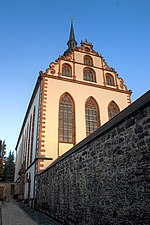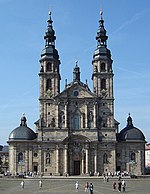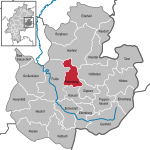Fulda station
1866 establishments in PrussiaBuildings and structures in FuldaHanover–Würzburg high-speed railwayRailway stations in Germany opened in 1866Railway stations in North Hesse

Fulda station (IATA: ZEE) is an important transport hub of the German railway network in the east Hessian city of Fulda. It is used by about 20,000 travellers each day. It is classified by Deutsche Bahn as a category 2 station. It is a stop for Intercity-Express, Intercity services and regional services. The original station was opened as part of the Frankfurt–Bebra railway in 1866. This was destroyed during the Second World War and rebuilt after the war. The station was adapted in the 1980s for the Hanover–Würzburg high-speed railway.
Excerpt from the Wikipedia article Fulda station (License: CC BY-SA 3.0, Authors, Images).Fulda station
Am Bahnhof,
Geographical coordinates (GPS) Address Nearby Places Show on map
Geographical coordinates (GPS)
| Latitude | Longitude |
|---|---|
| N 50.553888888889 ° | E 9.6847222222222 ° |
Address
Am Bahnhof
36037
Hesse, Germany
Open on Google Maps









